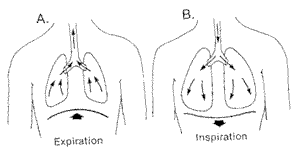Step 4: Practice Your Breathing Skills
Home Study
- The Don't Panic Self-Help Kit,
Section R: Practice Breathing Skills
Tape 2A: Practicing the Breathing Skills - Don't Panic,
Chapter 10. The Calming Response
Chapter 11. The Breath of Life
 During an emergency, our breathing rate and pattern change. Instead of breathing slowly from our lower lungs, we begin to breathe rapidly and shallowly from our upper lungs. If during this time we are not physically exerting ourselves, then it can produce a phenomenon called "hyperventilation." This in turn can explain many of the uncomfortable symptoms during panic:
During an emergency, our breathing rate and pattern change. Instead of breathing slowly from our lower lungs, we begin to breathe rapidly and shallowly from our upper lungs. If during this time we are not physically exerting ourselves, then it can produce a phenomenon called "hyperventilation." This in turn can explain many of the uncomfortable symptoms during panic:
- dizziness
- shortness of breath
- a lump in the throat
- tingling or numbness in the hands or feet
- nausea
- confusion.
The good news is that by changing your breathing you can reverse these symptoms.
By shifting your breathing rate and pattern, you can stimulate the body's parasympathetic response. This is the body's equally powerful and opposite system to the Emergency Response and is often called the relaxation response. For our purposes I will call it the Calming Response.
The table below lists the physical changes that take place in the Calming Response. As you can see, all of the primary changes of the Emergency Response are reversed in this process. One of the differences in these two physical responses is that of time. The Emergency Response takes place instantly in what is called a mass action: all the changes occur together. Once we flip on that emergency switch, it takes awhile for the body to respond to our calming skills. For this reason it is important for you to know what specific skills will reverse this emergency response and will help calm your body and clear your mind.
The Calming Response (Parasympathetic Response)
-
oxygen consumption decreases
-
breathing slows
-
heart rate slows
-
blood pressure decreases
-
muscle tension decreases
-
growing sense of ease in body, calmness in mind
You will now be introduced to three breathing skills. In later steps you will learn how to change your fearful thinking and your negative imagery, because each time you frighten yourself with catastrophic thoughts or images, you re-stimulate your body's emergency response. To begin with, however, you need a solid foundation in proper breathing.
Calming Your Breath
People who are anxious tend to breathe in their upper lungs (upper chest) with shallow, rapid breaths, instead of breathing into their lower lungs (lower chest). This is one contribution to hyperventilation: shallow, upper lung breathing.
The three breathing skills that I will describe next start with inhaling into your lower lungs. This is a deeper, slower breath. Below the lungs is a sheet-like muscle, the diaphragm, which separates the chest form the abdomen. When you fill your lower lungs with air, the lungs push down on the diaphragm and cause your abdominal region to protrude. Your stomach looks as though it is expanding and contracting with each diaphragmatic breath.

Two kinds of breathing, upper chest (thoracic) above, and lower chest (diaphragmatic) below.

The first breathing skill is called Natural Breathing, or abdominal breathing. In fact, this is a good way to breathe all day long, unless you are involved in physical activity. In other words, you should practice breathing this way all day long, since it provides for sufficient oxygen intake and controls the exhalation of carbon dioxide.
It's very simple and it goes like this:
Gently and slowly inhale a normal amount of air through your nose, filling your lower lungs. Then exhale easily. You might first try it with one hand on your stomach and one on your chest. As you inhale gently, your lower hand should rise while your upper hand stays still. Continue this gentle breathing pattern with a relaxed attitude, concentrating on filling only the lower lungs.
Natural Breathing
-
Gently and slowly inhale a normal amount of air through your nose, filling only your lower lungs. (Your stomach will expand while your upper chest remains still.)
-
Exhale easily.
-
Continue this gentle breathing pattern with a relaxed attitude, concentrating on filling only the lower lungs.
As you see, this breathing pattern is opposite of that which comes automatically during anxious moments. Instead of breathing rapidly and shallowly into the upper lungs, which expands the chest, you breathe gently into the lower lungs, expanding the abdomen.
The second technique is deep diaphragmatic breathing and can be used during times when you are feeling anxious or panicky. It is a powerful way to control hyperventilation, slow a rapid heartbeat and promote physical comfort. For this reason we will call it the Calming Breath.
Here's how it goes:
Calming Breath
-
Take a long, slow breath in through your nose, first filling your lower lungs, then your upper lungs.
-
Hold your breath to the count of "three."
-
Exhale slowly through pursed lips, while you relax the muscles in your face, jaw, shoulders, and stomach.
Practice this Calming Breath at least ten times a day for several weeks. Use it during times of transition, between projects or whenever you want to let go of tension and begin to experience a sense of calmness. This will help you become familiar and comfortable with the process. And use it any time you begin to feel anxiety or panic building. When you need a tool to help you calm down during panic, you will be more familiar and comfortable with the process.
The third technique is called Calming Counts. It has two benefits over Calming Breath. First, it takes longer to complete: about 90 seconds instead of 30 seconds. You will be spending that time concentrating on a specific task instead of paying so much attention to your worried thoughts. If you can let time pass without such intense focus on your fearful thoughts, you will have a better chance at controlling those thoughts. Second, Calming Counts, like Natural Breathing and the Calming Breath, help access the Calming Response. That means you will be giving yourself 90 seconds to cool your body out and quiet your thoughts. Then, after that time has passed, you will less anxious than you were.
Here's how this skill works:
Calming Counts
-
Sit comfortably.
-
Take a long, deep breath and exhale it slowly while saying the word "relax" silently.
-
Close your eyes.
-
Let yourself take ten natural, easy breaths. Count down with each exhale, starting with "ten."
-
This time, while you are breathing comfortably, notice any tensions, perhaps in your jaw or forehead or stomach. Imagine those tensions loosening.
-
When you reach "one," open your eyes again.
As you apply these skills, keep two things in mind. First, our breathing is dictated in part by our current thoughts, so make sure you also work on changing your negative thoughts, as well as your breathing, during panic. And second, these skills work to the degree you are willing to concentrate on them. Put most of your effort into not thinking about anything else -- not your worried thoughts, not what you will do after you finish the breathing skill, not how well you seem to be at this skill -- while you are following the steps of these skills.
You will find an audiotape in the Don't Panic Self-Help Kit called "Practicing Your Breathing Skills." It will train you in these three skills: Natural Breathing, Calming Breath and Calming Counts.
next: Step 5: Practice Formal Relaxation Skills - Part 2
~ back to Anxieties Site homepage
~ anxiety-panic library articles
~ all anxiety disorders articles
APA Reference
Staff, H.
(2009, January 11). Step 4: Practice Your Breathing Skills, HealthyPlace. Retrieved
on 2026, January 1 from https://www.healthyplace.com/anxiety-panic/articles/practice-your-breathing-skills
 WDP: Professionals' definitions make them sound completely different, but they may not be. The diagnostic criteria for "anorexia nervosa" focus on what people think and feel--about themselves, their bodies, and so forth. Activity anorexia is about what people do--how much they eat and exercise. My colleagues and I have argued that most cases diagnosed as anorexia nervosa, a "mental illness," are actually cases of activity anorexia, a problematic behavior pattern. You see, what people consciously think can be misleading.
WDP: Professionals' definitions make them sound completely different, but they may not be. The diagnostic criteria for "anorexia nervosa" focus on what people think and feel--about themselves, their bodies, and so forth. Activity anorexia is about what people do--how much they eat and exercise. My colleagues and I have argued that most cases diagnosed as anorexia nervosa, a "mental illness," are actually cases of activity anorexia, a problematic behavior pattern. You see, what people consciously think can be misleading. Calculated risks taken for the benefit of our own well being are worth taking. This form of movement is safer than standing still. Those who remain stationary become an easy target for misery of their own creation.
Calculated risks taken for the benefit of our own well being are worth taking. This form of movement is safer than standing still. Those who remain stationary become an easy target for misery of their own creation. Left picture, Jed Diamond, author of the bestseller Male Menopause.
Left picture, Jed Diamond, author of the bestseller Male Menopause.

 David, My Bipolar Story I am 30 years old and live in East Texas. While many people with bipolar disorder have a hard time staying in a relationship, I have been blessed to be able to stay married for 11.5 years now.
David, My Bipolar Story I am 30 years old and live in East Texas. While many people with bipolar disorder have a hard time staying in a relationship, I have been blessed to be able to stay married for 11.5 years now. Dr. Sajatovic also reviewed a study of a VA psychosis registry, looking at bipolar disorder in the VA system and age-related modifiers of clinical care. Interestingly, she reported, there are more than 65,000 individuals in the VA database with bipolar disorder, and more than a quarter are older than 65. "You don't have to be a statistician to figure out where we're going with this. There are a large number of individuals who are progressing into a later-life diagnosis of bipolar disorder."
Dr. Sajatovic also reviewed a study of a VA psychosis registry, looking at bipolar disorder in the VA system and age-related modifiers of clinical care. Interestingly, she reported, there are more than 65,000 individuals in the VA database with bipolar disorder, and more than a quarter are older than 65. "You don't have to be a statistician to figure out where we're going with this. There are a large number of individuals who are progressing into a later-life diagnosis of bipolar disorder." Comprehensive list of questions and answers about signs, symptoms and treatment of bipolar disorder and other related mood disorders.
Comprehensive list of questions and answers about signs, symptoms and treatment of bipolar disorder and other related mood disorders.